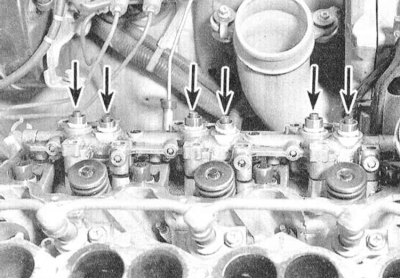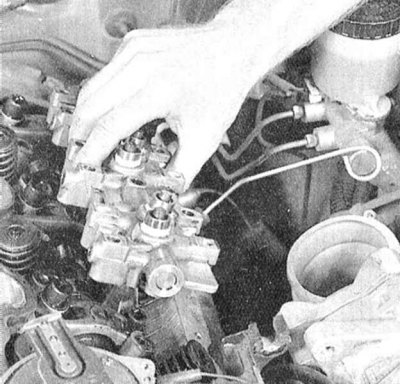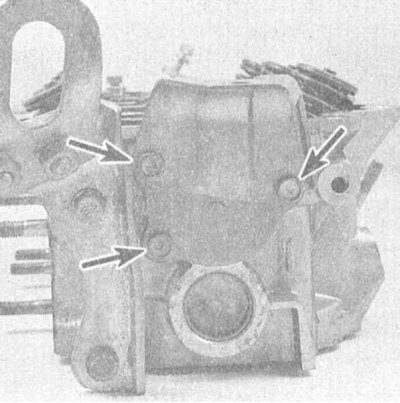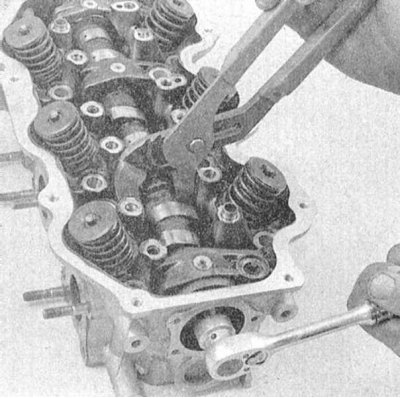
2. To fix the pushers in their guide, put rubber bandages on them.
Note. Accidentally fallen out pushers immediately return to the corresponding sockets of the guide assembly.

3. Remove the pusher guide assembly.
4. Remove the pushers one by one from their slots in the guide and fold them in an organized manner - each pusher must be installed exactly in its original place during assembly.
Attention! To avoid air pockets, try not to lay the pushers on their side or turn them upside down. Alternatively, the tappets should be stored in containers filled with clean engine oil.
5. Having filled the pusher into its seat, drown the plunger protruding from its upper end. If the stroke of the plunger exceeds 1 mm, then there is air in the pusher.
6. If you suspect that air has entered the pusher, install the rocker arms with axles and the cylinder head cover at the assembly site.
7. To bleed the tappets, start the engine at 1000 rpm and let it run without load for about 10 minutes.
8. Again remove a cover of a head of cylinders and take assemblies of yokes with axes and repeat the procedure described in paragraph 5. If it was not succeeded to remove air from a pusher, replace it new.
9. Assess the degree of wear of the pushers removed from the engine (see part General engine overhaul this chapter).
10. Installation is carried out in the reverse order, remember to lubricate the pushers with impellent oil before landing.
Camshafts
Removing
1. Remove the cylinder heads from the engine (see Section Removal and installation of cylinder heads).

2. Turn out fixing bolts and, having accurately prying, remove from the end face of a head facing a transmission a plate of a cover of a camshaft.

3. Holding the shaft by the flats from turning, release the bolt of its fastening. Turn out a bolt and remove a persistent plate.

4. Carefully prying with a small screwdriver, remove the camshaft oil seal from its seat - try not to damage the pin.
Note. Pushing the shaft through the hole in the thrust plate will make it easier to remove the stuffing box.

5. Carefully holding the shaft at both ends and making rotational movements, remove it from the cylinder head.
Note. Take care not to damage the bearings and shaft cams. A description of the procedures for checking the condition of the shaft and its bearings is given in Part DOHC engines of this chapter.
Installation
1. Lubricate the shaft bearing journals with molybdenum-containing grease, then carefully place the assembly in its original place in the cylinder head - try not to damage the bearing surfaces.
2. Reinstall the camshaft thrust plate, screw in the rear bolt and tighten it with the required force.
3. Having installed the shaft in the cylinder head, measure the value of its axial play (see part General engine overhaul this Chapter).

4. If the axial play of the shaft is out of range, a new thrust plate should be selected. Measure the thickness of the old plate and select a new one in order to bring the axial play of the shaft back to normal.
5. Install a new camshaft seal. Further assembly of the cylinder head is carried out in the reverse order to the dismantling of the components. For a description of the head installation procedure, see Section Removal and installation of cylinder heads.
Replacing camshaft seals
1. Replacing the camshaft seals can be done without dismantling the latter. It will be enough to remove only the timing belt and the corresponding timing gears. Old oil seals are removed by prying them with a screwdriver - try not to damage the shaft trunnions.

2. The seals are seated using a special mandrel, which can be used as an end head of the appropriate size, or a piece of pipe of a suitable diameter. The gland must be planted in its socket strictly perpendicular. Continue pressing the oil seal until it rests against the bottom of the socket in the body of the cylinder head.